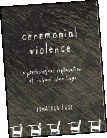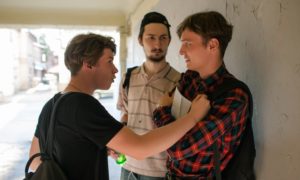 |
Jonathan Fast
The Overlook Press
333 pages. $25.95, $15.95 paperback.
School rampage (SR) shootings are “acts of terrorism” that “crush the spirit of the community and generate waves of despair across the nation,” declares therapist and social work professor Jonathan Fast in this new study. Although less than one hundredth of 1 percent of teenagers die in such shootings, one-third of students in a national poll believe an incident similar to the one at Columbine High School in Littleton, Colo., will happen in their school. Understanding extreme violence, says Fast, is “one of our most important tasks as a global community.”
For this qualitative study, Fast selected 13 American schoolground shooting cases from 1974 to 1999 – involving 15 adolescents – each of which had two or more victims. Fast’s Theory of Ceremonial Violence evolved through reconstructing these cases from documentary and legal evidence, the media and personal accounts. His theory describes shooter candidates as misfits coping with abuse, neglect, physical deficiency or psychological disorders. These misfits create their own place to belong in outsider groups such as Goths or skinheads. Often severely bullied, they are adept at hiding the extent of their disconnection.
Continued rejection by peers and adults builds alienation and anger. Thoughts of private suicide change to public suicide if two factors co-exist: a narcissist who craves attention and lacks empathy and a friend to share the rage, sometimes acting as a “violence coach.” Their suicide pact is payback to everyone who has injured them, in a public ceremony with weapons, music and clothing that recall ancient execution rituals.
After providing an overview of all 13 cases that illustrate his theory, Fast analyzes five cases in depth:
Brenda Spencer, 16, San Diego, 1979. The only female shooter trained her rifle on an elementary school across the street from her house, wounding eight children and a police officer and killing the school principal and custodian. Spencer told a newspaper reporter that she was shooting for fun, because she didn’t like Mondays.
Wayne Lo, 19, Great Barrington, Mass., 1992. This intelligent violin prodigy wandered around his prep school campus, shooting at random with his semiautomatic assault weapon. He killed one staff member and disabled another, then killed one student and wounded four before surrendering.
Evan Ramsey, 16, Bethel, Alaska, 1997. Like his father, who was in prison for an attempted shooting, Ramsey suffered uncontrollable rages. He moved through 10 foster homes. Ten days after his father phoned about his release from prison, Ramsey killed the school principal and a student and wounded 19 others with a shotgun.
Luke Woodham, 16, Pearl, Miss., 1997. Living with his smothering mother in a fundamentalist community, overweight Woodham was a loner until he joined a group led by senior Grant Boyette, who idolized Hitler and Satan. Boyette tutored Woodham in violence, starting with the brutal killing of Woodham’s dog. After a girl rejected him, Woodham murdered his mother with a butcher knife, then took a rifle to school and killed the girl and her friend, and wounded seven others.
Eric Harris, 18, and Dylan Klebold, 17, Littleton, Colo., 1999. The infamous Columbine High School shooting is the only case here in which the shooters committed suicide – the four other shooters listed above remain in prison with life sentences. Enacting an elaborate scheme, Harris and Klebold killed one teacher and 12 students, injuring almost two dozen more. Had their bombs worked, as many as a thousand people could have been killed.
Fast examines each shooter’s family dynamics, school and social interactions, adult interventions, the formation of shooting plans, and each shooting scene. Considering the diagnoses of court and other psychologists, he adds his own interpretations. He covers each case’s aftermath of survivor and community recovery, devoting an additional chapter to Columbine’s progress after 10 years, including the 2004 discovery of a police cover-up of a report of Eric’s uninvestigated death threats.
Fast’s final chapter offers prevention strategies and interventions that reduce school violence, including anti-bullying programs and safe-school policies, which are becoming common. Also, threat assessment techniques work because young SR shooters reveal their inclinations beforehand. Readers notice how many students in these cases heard classmates’ violent threats, but never told an adult. In Bethel, Evan Ramsey invited at least 20 of his friends to a safe spot to witness his shooting – and they turned up.
Fast finds that gun control is the pivotal unresolved issue; school violence increased with easy access to automatic weapons. Among his cases, three shooters’ guns were gifts from their parents. After a 1998 shooting in Jonesboro, Ark., in which five people were killed (one of the cases not covered in depth), President Bill Clinton introduced gun control measures that never passed by Congress. A slain Columbine student’s father dedicated his life to anti-gun activism, but none of the proposed post-Columbine legislation became federal law. Fast borrows his concluding lines from Britain’s handgun ban imposed after a Scottish gunman killed16 kindergartners in 1996: “The widespread ownership of handguns is not compatible with a sane, civilized or safe society.”
Fast’s accumulation and analysis of all this violence data is impressive, thorough, and unsettling, but errors in key details undermine the reader’s trust. The master list of shootings contains the wrong date for the San Diego event and the wrong state for the Bethel shooting. Jacket copy moves the Bethel shooting to Anchorage. Continuity problems and frequent typos are confusing. Fast’s insights on common threads among these shootings are too important to obscure with poor presentation. The book provides a fresh awareness of these harrowing cases that could serve as an impetus for new attempts to prevent school violence. (212) 673-2210, http://www.overlookpress.com.






























